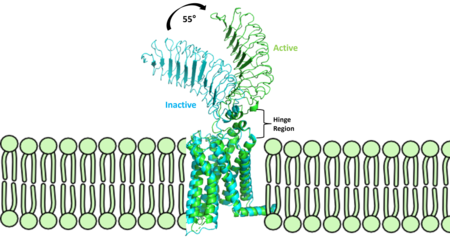Sandbox Reserved 1780
From Proteopedia
(Difference between revisions)
| Line 4: | Line 4: | ||
=== Active and Inactive Form === | === Active and Inactive Form === | ||
| - | [[Image: | + | [[Image:Finalmorphpic2.png|450 px|right|thumb|Figure 2: Inactive form of the thyrotropin receptor shown in blue (PDB: 7T9M). Active form of the thyrotropin receptor shown in green (PDB: 7T9I).]] |
The TSHR protein exists in two states: active and inactive (Figure 2) (GREEN LINK ?). The <scene name='95/952708/Tshr_chainr/4'>TSHR active form</scene> (GREEN LINK take away extra molecules) exists in dynamic equilibrium where <scene name='95/952708/Tsh_7t9i/1'>TSH</scene> (GREEN LINK make TSH one color) binding favors the active state. In this active state, TSH will bind and keep the active state in the up position because of clashes between bound TSH and the cell membrane.<ref name="Faust" />. Glycosylations of the Asn52 residue cause this clash (GREEN LINK) on the <scene name='95/952707/Tsh_7t9i/1'>α-subunit of TSH</scene>. The addition of N-acetyl glucosamine modifications creates steric clashes between TSH and the cell membrane, keeping TSHR in the active state. | The TSHR protein exists in two states: active and inactive (Figure 2) (GREEN LINK ?). The <scene name='95/952708/Tshr_chainr/4'>TSHR active form</scene> (GREEN LINK take away extra molecules) exists in dynamic equilibrium where <scene name='95/952708/Tsh_7t9i/1'>TSH</scene> (GREEN LINK make TSH one color) binding favors the active state. In this active state, TSH will bind and keep the active state in the up position because of clashes between bound TSH and the cell membrane.<ref name="Faust" />. Glycosylations of the Asn52 residue cause this clash (GREEN LINK) on the <scene name='95/952707/Tsh_7t9i/1'>α-subunit of TSH</scene>. The addition of N-acetyl glucosamine modifications creates steric clashes between TSH and the cell membrane, keeping TSHR in the active state. | ||
Revision as of 22:53, 13 April 2023
| This Sandbox is Reserved from February 27 through August 31, 2023 for use in the course CH462 Biochemistry II taught by R. Jeremy Johnson at the Butler University, Indianapolis, USA. This reservation includes Sandbox Reserved 1765 through Sandbox Reserved 1795. |
To get started:
More help: Help:Editing |
| |||||||||||
References
- ↑ 1.0 1.1 1.2 Faust B, Billesbolle CB, Suomivuori CM, Singh I, Zhang K, Hoppe N, Pinto AFM, Diedrich JK, Muftuoglu Y, Szkudlinski MW, Saghatelian A, Dror RO, Cheng Y, Manglik A. Autoantibody mimicry of hormone action at the thyrotropin receptor. Nature. 2022 Aug 8. pii: 10.1038/s41586-022-05159-1. doi:, 10.1038/s41586-022-05159-1. PMID:35940205 doi:http://dx.doi.org/10.1038/s41586-022-05159-1
- ↑ 2.0 2.1 Nunez Miguel R, Sanders J, Chirgadze DY, Furmaniak J, Rees Smith B. Thyroid stimulating autoantibody M22 mimics TSH binding to the TSH receptor leucine rich domain: a comparative structural study of protein-protein interactions. J Mol Endocrinol. 2009 May;42(5):381-95. Epub 2009 Feb 16. PMID:19221175 doi:10.1677/JME-08-0152
- ↑ 3.0 3.1 Chen, C.-R., McLachlan, S. M., & Rapoport, B. (2007). Suppression of thyrotropin receptor constitutive activity by a monoclonal antibody with inverse agonist activity. Endocrinology, 148(5), 2375–2382. https://doi.org/10.1210/en.2006-1754


